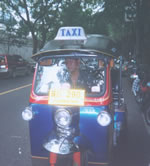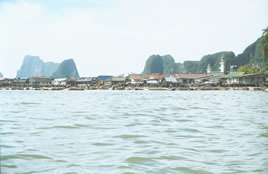
This page is intended to help give you some suggestions about ways to travel to and from Thailand, as well as travel while within the nation's borders. First, a little preparation: when should you go? This handy outline explains the best weather and thinnest crowds. Next: how should you get there? This section explains options for air travel as well as overland and cruise alternatives. Then a quick primer on how to get around once you're within Thailand. Finishing, you'll learn a little bit about island excursions and elephant rides. Go to it! |
\ |
How Should You Get There?Air TravelThe easiest way for most travelers to get to Thailand is to fly into Don Muang, Bangkok's international airport. These days, shopping around on the Web makes it as easy if not easier than dealing with travel agents. If you've never purchased airline tickets on the Web before, why not start as you prepare for your first trip to Thailand? The most reliable Web resources are Expedia, CheapTickets, Travelocity, Orbitz and Priceline. Keep in mind, just as with conventional travel agents, purchasing your tickets as far in advance as possible ensures you the best price. If you decide that you'd still prefer to use a travel agent, it's still a good idea to check the prices they offer against ones you'll find on the Web. Traveling with a group can be beneficial if you book a group tour. And if you're traveling on a real shoestring budget, you can also look into flying cheap as an air courier. Find out how. Whatever you decide to do, once you're in Thailand, immediately check with your airline to confirm your departure flights out of Thailand - flights in and out of Thailand are often overbooked, and the organizational systems of the country can at times leave something to be desired. Better to be safe than sorry! One last consideration: you'll be charged an "airport tax" of 500 baht (around $12.50 - $14.00) per person when you leave, so don't show up to the airport broke when you're ready to go home! Non-Air TravelEntering Thailand from one of its border nations or ports is also a consideration. Arriving by boat is strictly up to the cruise lines - don't monkey around with independent "charters", you're just asking for trouble. Check with Travelocity for the best deals on cruises into Thailand. The only other legitimate boat travel to consider is crossing the Mekong River from Laos on a ferry. Overland travel can be romantic and exciting - if you can afford to travel on the Eastern or Oriental Express (U.S. $1,000+). All other trains will be crowded and uncomfortable, although the fares will be the cheapest possible. (A precaution: the border between Myanmar [Burma] and Thailand is a volatile, unpredictable place for foreigners, so steer clear of it if possible, or register with the US Embassy before traveling there.) Riding the Eastern or Orient is also the only way to enter Thailand overland from Singapore or Kuala Lumpur. Approaching from the south, Malaysia offers four border crossings with express trains: two on the west coast, one midland, and one on the east coast. The journey typically requires an overnight stop in Butterworth, Malaysia, in order to comfortably make train connections. Entering Thailand from Laos, Cambodia or Myanmar can be made by hired car, bus, or on foot. A word to the wise: the borders are seething with con-artists waiting to descend on unsuspecting tourists, so keep your wits about you if this becomes your preferred method of travel. |
Island Excursions
If you travel to the Southern region of Thailand, chances are good you'll need to take a ferry to get from the mainland to an island. Ferries are available from any port near an island tourist destination and are very reasonably priced. Once on an island like Ko Samui or Phuket, you may choose to rent a motor scooter. But head the cautions listed above! There are traffic fatalities approximately every other day in these places, and a good deal of the accidents arise from inattentive visitors. And if you do make it onto any of the islands, chances are good that you'll want to travel on various types of boats as well. There are small cruises available with reef snorkeling, dolphin-sighting, and transport to some of the more remote, secluded islands. Prices vary depending on port, season, and your skills as a haggler. |
 |
 |
Elephant Rides!
Lastly, while in the more remote towns, beaches and jungles, you might want to try a ride on an elephant! The elephant is the symbol of Thailand, since the borders of the nation form an image similar to an elephant's head. You'll see images of elephants many of the places you travel, so why not take an opportunity to ride an elephant as well?! (Do please keep in mind that elephants who work their lives out on paved city streets typically die young and beaten down; elephants are heavy and have feet that were not meant to walk on pavement, so if you decide to try this type of transportation, please consider a compassionate choice.) |
 |
 |
 |
 |